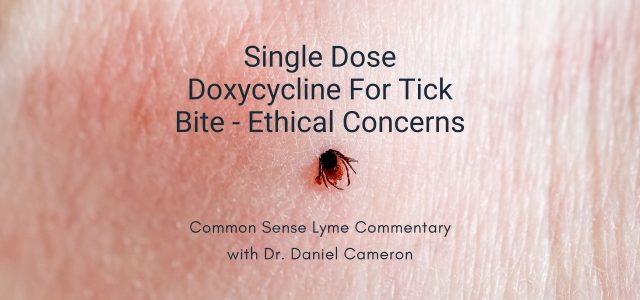
What if you did everything right after a tick bite—and still ended up sick?
That’s what happened to a 37-year-old woman who followed medical advice after a hike in New York’s Hudson Valley. She removed an engorged tick and went to urgent care. The provider gave her a single pill—200 mg of doxycycline—and told her it would prevent Lyme disease.
Weeks later, she developed brain fog, crushing fatigue, and joint pain. It turned out she did have Lyme disease, and possibly other tick-borne infections too.
Her case raises important ethical questions: Are patients being told enough? Are they being protected—or falsely reassured? And are we doing right by those who follow the rules?
The Promise of a Single Pill After a Tick Bite
The CDC currently recommends a single dose of doxycycline after a tick bite in certain cases. The idea is simple: take the antibiotic early, and you might prevent Lyme disease from taking hold.
But there’s a catch: this one-pill approach was based on a small study published in 2001. It mostly looked at preventing the bull’s-eye rash—not the full illness.
What’s more, the study didn’t follow people long enough to detect cases of Lyme disease that develop without a rash, or cases involving co-infections like Babesia.
What This Patient Wasn’t Told
This woman wasn’t warned about the limits of the single-dose strategy. She wasn’t told that:
-
It may not prevent the whole disease—just the rash.
-
It doesn’t protect against other infections ticks can carry.
-
It only works in very specific situations (right kind of tick, right timing, right area).
-
If symptoms appear later, Lyme disease testing can be unreliable.
Because she believed she was protected, she waited too long to seek further care—and her test came back negative at first, adding to the confusion.
By the time she arrived at my clinic, her illness had worsened.
Why This Isn’t Just a Medical Issue—It’s an Ethical One
1. Patients Deserve Full Information (Autonomy)
She should’ve been told that the one-pill approach isn’t a guarantee. Without all the facts, she couldn’t make a truly informed choice.
2. Care Should Be Tailored, Not Just Protocol (Beneficence)
She lived in a high-risk Lyme area. The tick was attached long enough to transmit disease. She might have benefited more from a longer antibiotic course. Instead, a “one-size-fits-all” approach failed her.
3. False Reassurance Can Do Harm (Non-Maleficence)
Believing she was safe delayed her diagnosis and treatment. That delay caused more suffering—and made recovery harder.
4. The System Isn’t Fair for Everyone (Justice)
This strategy doesn’t work well for kids under 8, pregnant women, or people who don’t have easy access to care. It assumes everyone knows what kind of tick bit them—and can get treatment within 72 hours. That’s not realistic for many.
What Happened When She Got the Right Help
When she finally got to my office, we ran new tests. Her Lyme Western blot confirmed infection. She also had symptoms of Babesia, a parasite that doxycycline doesn’t treat. On top of that, she had orthostatic intolerance (POTS), which had never been linked to her tick bite before.
With a more complete treatment plan—including antibiotics and supportive care—she began to feel better. But the road was longer than it needed to be.
Bottom Line: A Simple Solution Isn’t Always the Right One
The idea of “just one pill” sounds great—but it can create a false sense of safety. When patients aren’t told the full story, they lose the chance to make informed decisions. And when symptoms are dismissed, the consequences can last for months or even years.
We need to do better. That means:
-
Being honest about what the single-dose approach can and can’t do.
-
Offering follow-up when patients remain unwell.
-
Considering co-infections and other risks—not just following a checklist.
Because when it comes to Lyme disease, patients deserve more than a protocol. They deserve a plan.



Excellent article! The medical professionals in the USA are trying to save the world with their stingy use of antibiotics. With all the known downsides of Lyme, Babesia or some other infection why not err on the side of a more aggressive and comprehensive treatment program? Heck you walk into a dermatologists office and they give out a six month regiment of antibiotics for treating pimples without blinking an eye.
(Revised comment)
Yes yesterday I had a tick removed that was on me for one month and they gave me two doxycycline pills here at urgent Care in bartlesville Oklahoma I’m freaking out
Did you seek further help from an infectious diease doctor? Did they put you on a larger more powerful dose od Docy? and for what period of time?
Hope you are doing better, I just contracted the diease two weeks ago,
Gary R.
Various Departments of Health refuse to do a followup survey and study of patients that have received this single or double dose procedure to determine if it is efficacious. Many pharmacists are now allowed to do an assessment and provide patients with a post tick-bite prophylaxis. The Registrar and College know full well that one or 2 pills won’t prevent Lyme and TBDs but have chosen to ignore this under the protective umbrella of self-appointed medical experts who neither see or treat cases of persistent Lyme disease (LD) and who owe their loyalty to the IDSA. Patients will be upset when they learn how restricted the evidence for this procedure is. Now they can’t claim workmen’s compensation because they can’t pass the test and chronic Lyme is not a recognized condition.
In 2012, after yrs of searching for a Dr I was sent to a movement disorder specialist at UNC CHAPEL Hill, NC, was given proper meds and care and had settled in to a great life on the farm! I. got sick in late September 2023. With in 2 days I was almost comatose, could not care for myself, couldn’t feed myself,and I have no memory of a hospital stay. My husband and our two sons were there for me. The first hospital tested me for EVERYTHING they could come up! Everything was “normal”, Since that hospital couldn’t give me a DX, I was sent to a second hospital ( very well respected medical school) in Greenville, NC. My husband was there waiting for me. After 2 hrs in their ED a Dr came in looked at me , asked me to squeeze his fingers, which I did once. and turned to my husband and said “ she has Parkinson’s disease” turned around , left my room, and he was never seen again around me. After 3 more days of absolutely nothing being done, I went home with my husband and son’s. Home health was instrumental in getting the right things lined up for me to regain my strength to walk and to be as close as possible to the person my husband married almost 52years ago.
I went home without a DX. It was February 2024 that we got our answer …Lymes Disease! We had to ASK for the test to be done! Doxycycline was prescribed and I got better. Three times I have been given Doxycycline for flare ups until finally my GP asked if I would try taking doxycycline daily. I was at my wits end with having no help from the DOCTORS. FROM DUKE UNC-ch, Greenville to our local hospital. Of all the drs I saw two said I have LD. Not a single Dr had it on their radar, so no test was called for nor even considered in all the testing that was done! I am still fighting Lymes Disease. Now, my issues with Parkinson’s are flaring up in numerous ways and LD isn’t taking a back seat!
One sentence I keep hearing and I hate it: “North Carolina doesn’t have that kind of tick! “ Well, I beg to differ! As long as these doctors put their heads in the sand, we won’t get a DX! I wish I could get a couple of drs to take my place just one week! Bet they wouldn’t let the sun go down until that changed!
Thank you, Dr. Camerone. People are still being treated this way and it’s getting worse. The tick population is exploding in Minnesota this year. I can only imagine how bad it is on the coast. Her Lyme disease could have been prevented. Let them have it, doc!
There are certainly more tick now than were present when I grew up on a farm in western Minnesota
Thank you for this article. I am a pharmacist and have helped my child get over mis-diagnosed and mis-treated tick-related illnesses with functional and Lyme-literate physicians who were incredible. BUT… it cost so much time and money (health insurance does not reimburse) and all because primary care providers are INADEQUATELY trained on tick illnesses and their treatment.
All this to say I know a lot about ticks, so when I found a bullseye under my arm mid-March (!, and after a snowstorm no less!), and my PCP provided me a prescription for one 200 mg doxycycline capsule, I was outraged. She would not budge, even after I provided her studies and materials. “It’s what the CDC recommends,” she kept saying.
Until we fix the guidelines at the CDC patients–and providers–will continue to be blind to treatment options.
I am lucky–I keep antibiotics in stock and had a full month’s supply on hand. And I am also an herbalist and know how to treat with plants. But I should not have to buy antibiotics from another country in order to get adequate treatment in America.
Thank you for your excellent work. And thank you for letting me vent! Peace…
I had my second tick bite in Ontario, Canada with bulls eye rash in Aug 2025. The first was 2006 but undiagnosed and not understood until 2014. Nothing offered for cfs. I have recently seen my Opthalmologist as my eye sight is suddenly and quickly deteriorating. I suspect the recent bite. I am a California resident and terrified to permanently lose my sight at 65, and raising a special needs young adult. I need help. Drs oblivious here in California as they were on Manitoulin Island in Canada. What do I do?
There are so many cause vision loss. I urge my patients look beyond Lyme to be sure they do not overlooking a treatable condition